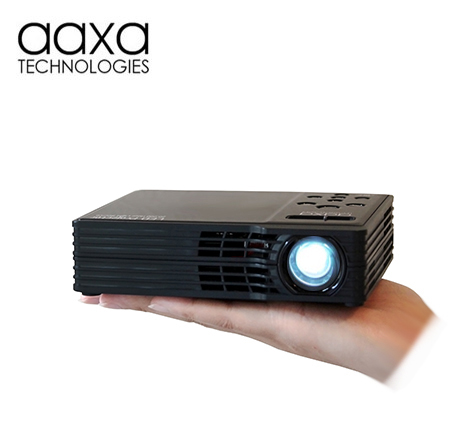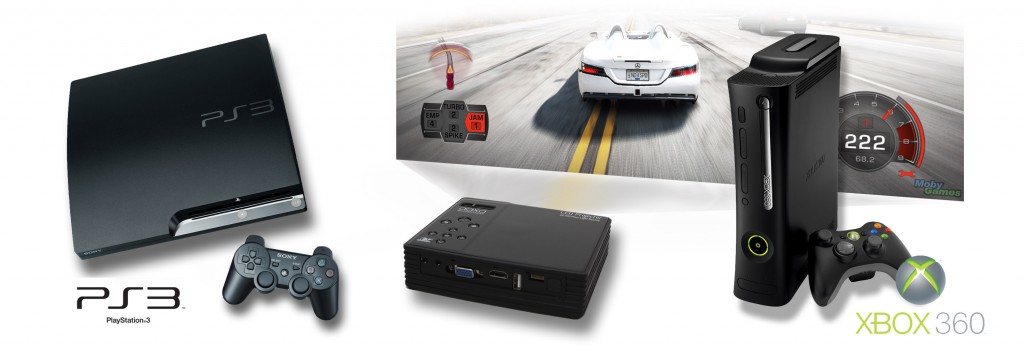 Pico projectors have grown immensely since we started this blog, and now there are several newer models which feature brighter pictures in smaller packages.
Pico projectors have grown immensely since we started this blog, and now there are several newer models which feature brighter pictures in smaller packages.
When considering a few projectors, you have to take into consideration a number of factors depending on how you would use the projector. Some of these might include portability, brightness, inputs, and price. All pico projectors have improved on all of those categories over time and are now a great option for projecting on the go.
When you think of Pico Projectors, a few big names come to mind, Acer has their C120, 3M has their MP220, Optoma has the PK320, and AAXA has the P4-X. All of these models are great at what they do, but which one is the best? To do that, we got all four models in-house and put them side by side to compare and contrast the differences that make some better than others.
Arguably the biggest name brand within these four models is Acer, who make the C120. This projector is a pretty barebones projector, it is meant to do one thing, but does it do it well? The C120 has only one input port on the back of it, a USB port. This USB port can be used with a Windows PC to display images on it’s 1280×800 projection screen. The drawback to this is that if you have a Mac, you are out of luck. If you want to display anything via VGA, HDMI, or MicroSD, you are also out of luck. This makes the C120 lack versatility, which in turn makes it less useful. It is the cheapest of the bunch, but we can’t recommend it as an everyday machine. The C120 MSRPs for $229.
The 3M MP220 is our next contender, weighing in at 15 ounces, it is the heaviest pico projector on our chopping block. The MP220 is a good competitor to other pico projectors in all categories, the brightness is on par (although it falls a bit short compared to some higher end ones), it has a decent resolution of 1024×600, and is portable enough to put into a bag. The MP220 has a few inputs for most of your needs, such as VGA and a universal plug for RCA, Apple devices, and more. The lack of a HDMI port leaves us feeling like it could have been better, as this limits the number of devices you can use with it dramatically. The MP220 MSRPs for $336.
AAXA is known for it’s high quality and high value projectors, and the P4-X is their latest attempt at bringing another one to the market. The P4-X is the most versatile projector we’ve seen in this roundup, supporting everything from HDMI to VGA to AV inputs, giving you a wide range in choices for connecting devices. The P4-X also stacks up in brightness very well, providing a 95 lumen rating while on AC power, and a 55 lumen rating if operating off of a battery. Overall for the price, we think the P4-X is a solid purchase for anyone needing a portable projector. The P4-X MSRPs for $299.
The Optoma PK320 is the last projector in our group, and is also one of the smaller projectors we reviewed. The PK320 has a wealth of inputs including the usual HDMI, AV, VGA and Mini USB, giving you many options for connecting devices to the projector. The brightness was on-par with the P4-X, giving you 100 lumens of power, however, that dips down to 25 lumens if you are running on battery power, which can be a stark difference if you are not in a dark environment. The main difference in the PK320 is it’s price, coming in at $399 retail, it is the most expensive of the group. We think it’s a solid option but might be a bit pricey for some people.
All of these projectors have their own pros and cons, but we think the best overall, and the best for the money is AAXA’s P4-X. It has enough inputs to satisfy almost any device, and is bright enough to give presentations with ease. Check out the Amazon links to all of these products below and decide for yourself.

















 CES is a press and industry only conference, but we’re giving you a chance to learn exactly what you want to know from the heart of the action this week. (Reuters)Peter Nowak is at the annual Consumer Electronics Show in Las Vegas this week to give you a sneak peak into the future of home entertainment, communication technology, and gadgets designed to change the world as we know it.
CES is a press and industry only conference, but we’re giving you a chance to learn exactly what you want to know from the heart of the action this week. (Reuters)Peter Nowak is at the annual Consumer Electronics Show in Las Vegas this week to give you a sneak peak into the future of home entertainment, communication technology, and gadgets designed to change the world as we know it.







